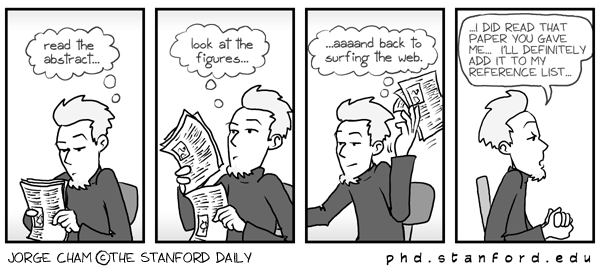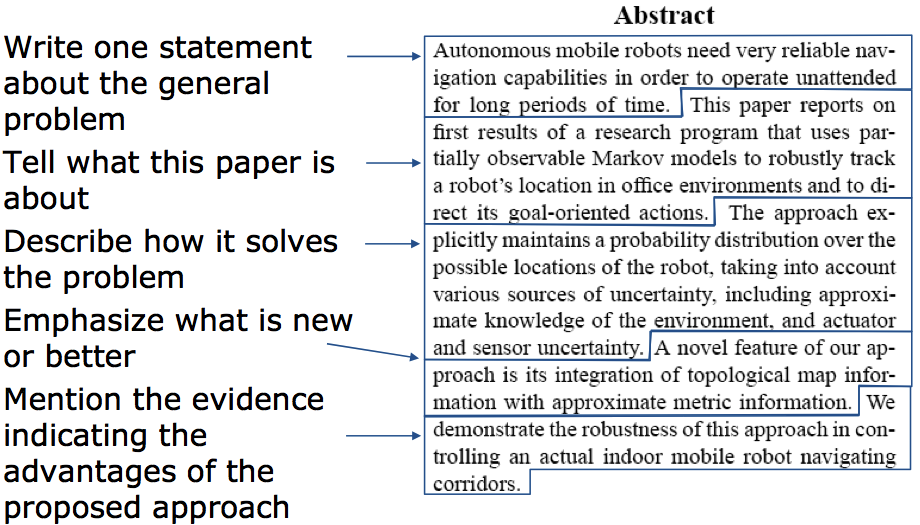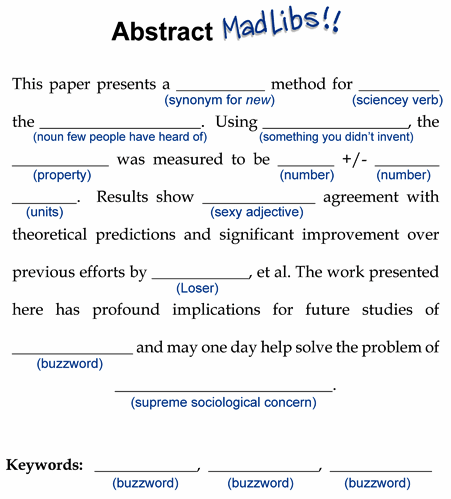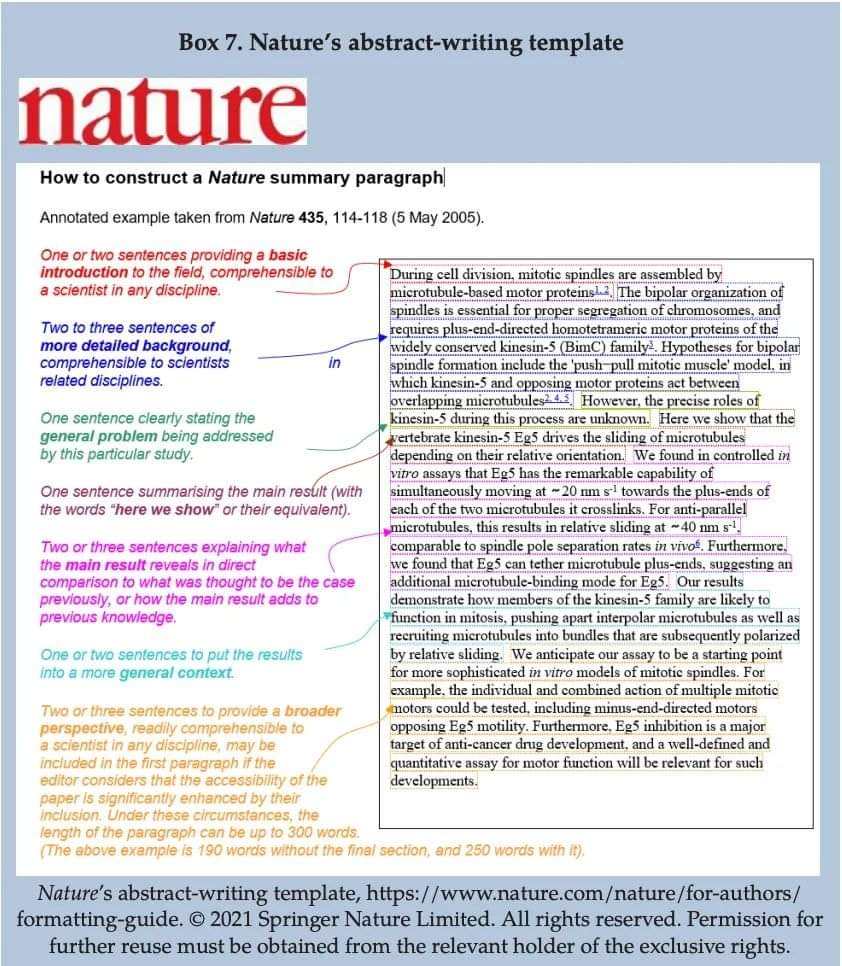Writing an Effective Abstract
The significance of a paper tends to be in inverse proportion to the length of the abstract.
The shorter the abstract, usually the more powerful the results. So the challenge is to keep it
concise while at the same time conveying the key results and ideas behind the paper.
The abstract should be self-contained and intelligible before one has read the paper.
Shahn Majid [8]
State the problem, your approach and solution, and the main contributions of the paper.
Include little if any background and motivation. Be factual but comprehensive.
The material in the abstract should not be repeated later word for word in the paper.
Jennifer Widom
Writing an effective abstract will improve the chances of your manuscript being accepted, encourage people to read it, and increase its impact.
An abstract is a condensed version of the manuscript, which highlights the major points covered, concisely describes its content and scope, and highlights its core points in abbreviated form. It is usually the first section read and sets the tone of the paper for the reviewer.A 4-Line Simple Abstract
- Many papers are badly written and hard to understand.
- This lack of effort is a pity, as good ideas may go unappreciated.
- Following simple guidelines can dramatically improve the quality of your papers.
- Your work will be used more, and the feedback you get from others will in turn improve your research.
It must be concise and easy to read and must cover the important insights of the paper.
An abstract should be the sexy start of a paper: it tells the reader early why he should read your paper. Do not just summarize, sell it! A good abstract tells us why we should read this paper, it does not outline all contributions of the paper. Convince us early that your paper is important. For example, the basic cooking recipe for a good 4+ sentence abstract is: (1) state the problem, (2) say why it is interesting, (3) say what your solution achieves, and (4) say what follows from your solution. [4]
Such abstracts may also be published separately in bibliographical sources. They allow other scientists to quickly scan the large scientific literature, and decide which articles they want to read in depth. The abstract should be a little less technical than the article itself; you do not want to dissuade your potential audience from reading your paper. Note that your abstract should be one paragraph, of 100-250 words, which summarizes the purpose, methods, results and conclusions of the paper. Do not use abbreviations or citations in the abstract. It should be able to stand alone without any footnotes.
How to Craft a Basic Abstract
Start with a draft of the complete manuscript and follow these steps (based on [2]): 
- Identify the major objectives and conclusions..
- Identify phrases with keywords in the methods section.
- Identify the major results from the discussion or results section.
- State your hypothesis or method used.
- Assemble the above information into the single paragraphs of the 4+ sentence abstract.
- Omit background information, literature review, and detailed description of methods.
- Remove extra words and phrases.
- Revise the paragraph so that the abstract conveys only the essential information.
- Check to see if it meets the guidelines of the targeted journal or conference.
- Give the abstract to a colleague (preferably one who is not familiar with your work) and ask him/her whether it makes sense.

If these steps do not provide sufficient insights on how to write a good abstract bottom-up, start reading below for good ways of designing the abstract top-down.
Another Example
Here is another example on good section of abstract. Grisetti et al. chose Probabilistic Navigation in Partially Observable Environments by R. Simmons and S. Koenig (IJCAI '95, Montreal Canada, July 1995.) to explain what a good abstract is about as it iscrepresentative of a wide class of good papers and an interesting robotics paper. To the right their explanations.
Expanding the 4+ Sentence Abstract (Before Writing the Paper)
You will realize that you can expand this abstract easily over time and detail it (based on [4, Balch 2012, Koopman 1997]: 
- Stating the problem: Here, you want to address the problem (E.g., "We address the problem of robot navigation across unmapped rough terrain") but not the solution. You can include some background (A sentence or two about other approaches; yours or others. E.g., "Smith and Jones address this by building a polygonal model of the obstacle field, creating a visibility graph, then applying Dijkstra’s algorithm."), from [Balch, 2012].
- Say why it is interesting: You may want to discuss importance (How would a solution to this problem change the world? Remember that it’s not obvious to everyone else how important this problem is. E.g., "A solution to this problem will enable more rapid validation of the efficacy of sleep medication."), new capabilities (What can we do now that we couldn’t do before? Quantify if possible. E.g., Our approach enables robots to climb trees five times more quickly than was possible before.), and faced challenges (Why is this problem hard? and/or What difficulty do other solutions face?, E.g., "In order to solve this problem a robot must know its location to within 1mm." and "Traditional approaches to this problem are exponential in the number of obstacles in the environment."), from [Balch, 2012].
- Say what your solution is / what it achieves: You may want to discuss your insight (What did you discover? How did you approach the problem differently? E.g., "By framing the problem as an optimization task, we are able to leverage a linear time algorithm."), your solution (Provide some specific details about the solution. E.g., "Our algorithm measures the standard deviation of the quantitative features in each dimension, then sorts the result, providing an optimal solution.') and evidence of your success (Summarize the evidence you have for your approach: A proof, an implementation, or quantiative results. E.g., "The algorithm was implemented on a monkey-based robot and shown to perform 17% faster than a dog of similar mass."), from [Balch, 2012].
- Say what follows from your solution: What are the implications of your answer? Is it going to change the world (unlikely), be a significant "win", be a nice hack, or simply serve as a road sign indicating that this path is a waste of time (all of the previous results are useful). Are your results general, potentially generalizable, or specific to a particular case? [Koopman, 1997]
You should clearly say what your contribution is. Reviewers are lazy, they do not want to have to figure out what your message is. Spend some time telling us exactly what your contribution is. Spell it out, do not assume we will read the paper carefully. [4]
What else to look out for? 
Many publications have a required style for abstracts; the "Guidelines for Authors" provided by the publisher will provide specific instructions. Stay within the publisher’s guidelines, or your manuscript might be rejected.
Koopman (1997) puts it perfectly: "An abstract must be a fully self-contained, capsule description of the paper. It cannot assume (or attempt to provoke) the reader into flipping through looking for an explanation of what is meant by some vague statement. It must make sense all by itself. Some points to consider include:
- Meet the word count limitation. If your abstract runs too long, either it will be rejected or someone will take a chainsaw to it to get it down to size. Your purposes will be better served by doing the difficult task of cutting yourself, rather than leaving it to someone else who might be more interested in meeting size restrictions than in representing your efforts in the best possible manner. An abstract word limit of 150 to 200 words is common.
- Any major restrictions or limitations on the results should be stated, if only by using "weasel-words" such as "might", "could", "may", and "seem".
- Think of a half-dozen search phrases and keywords that people looking for your work might use. Be sure that those exact phrases appear in your abstract, so that they will turn up at the top of a search result listing.
- Usually the context of a paper is set by the publication it appears in (for example, IEEE Computer magazine's articles are generally about computer technology). But, if your paper appears in a somewhat un-traditional venue, be sure to include in the problem statement the domain or topic area that it is really applicable to.
- Some publications request "keywords". These have two purposes. They are used to facilitate keyword index searches, which are greatly reduced in importance now that on-line abstract text searching is commonly used. However, they are also used to assign papers to review committees or editors, which can be extremely important to your fate. So make sure that the keywords you pick make assigning your paper to a review category obvious (for example, if there is a list of conference topics, use your chosen topic area as one of the keyword tuples).
Writing an efficient abstract is hard work, but will repay you with increased impact on the world by enticing people to read your publications. Make sure that all the components of a good abstract are included in the next one you write."
